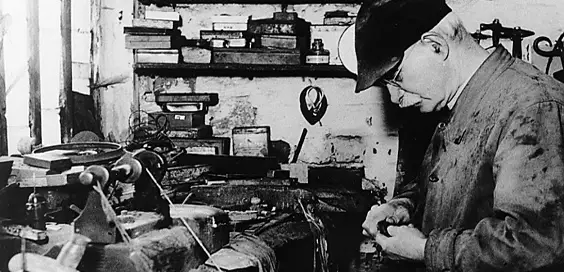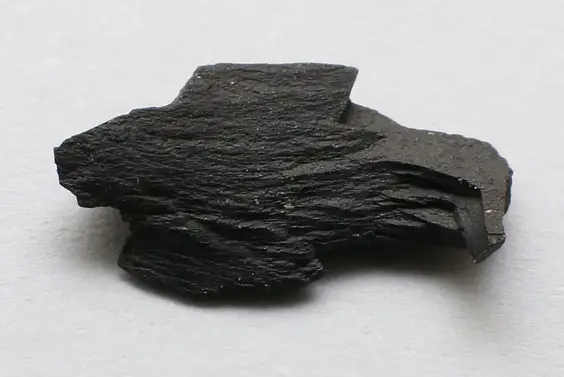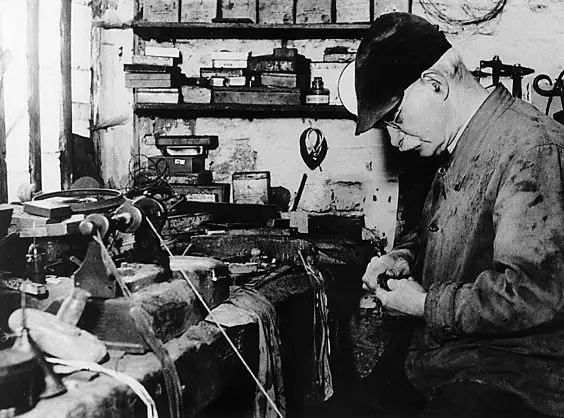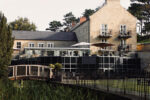The History of Whitby Jet

By Andrew White
Jet is one of Whitby’s most famous products. Indeed many people who have never been to Whitby know of Whitby jet. It is a type of fossilised wood, related to both coal and lignite, from an ancient tree similar to the modern araucaria or monkey-puzzle tree. Such trees flourished in the forests of the Jurassic period, some 180 million years ago. Unlike coal, jet does not occur in predictable seams. Its preservation as a fossil was relatively chancy and although the strata in which it is found can be readily identified it occurs as discontinuous lumps.
Early jet workers discovered enough raw materials to satisfy them on beaches and under cliffs, wherever the jet had been eroded out. They discovered that it cut relatively easily and moreover would take a high polish, producing that distinctive deep black known as a result as ‘jet black’. Jet was first worked in quantity by the prehistoric people known as the Beaker People, who used it for buttons and toggles, and slightly later, during the Bronze Age (c.1800-700 b.c.), it was in demand for ornaments such as necklaces.

Sample of unworked jet (about 15 mm long)
Image: Geni [CC BY-SA 4.0]
“Highly prized”
Good examples of the latter can be seen in Scarborough Museum and at the Yorkshire Museum in York. At Scarborough is a necklace from a barrow at Man Toft, Egton, consisting of 35 shaped beads and spacers. From some necklaces we can tell that the craftsman was attempting to copy some other material such as amber, for the spacers are frequently marked with lines exactly where the strings would be seen passing through a semi-transparent substance. Jet, then, was worked as an alternative to other soft and workable substances such as amber and shale, but it was widely traded and no doubt highly prized for its colour and perhaps for the magical qualities it was assumed to possess.
Jet workshops were established in York in Roman times and many ornaments have been found there. As it was a cosmopolitan city we must be careful not to assume that all jet in York came from Whitby. Spain also had supplies of jet and the Romans were adept at bringing the luxuries of their empire to markets. In Anglo-Saxon times jet continued in popularity, and there are many objects of jet from the site of Streanaeshalch. These include small crucifixes and beads, just the sort of religious item that continued to be made in jet throughout the Middle Ages. Interestingly, a number of jet discs and a part-finished jet bangle show that jet was being worked actually on the site of the monastery. They bear the marks of turning on a pole lathe. It is hard to see these bangles as anything but fashionable female jewellery, suiting the high-born ladies who lived here as nuns.

A Whitby jet worker at his bench. He appears to be carving by hand though many photographs of jet workers show only the polishers at work with their wheels
“Cramped conditions”
All this work was done on a very small scale, however, and casually found jet was probably sufficient for the purposes. It was around 1800 that a Captain Tremlett, a naval pensioner, saw the opportunities of turning jet items commercially, rather than carving everything. With two experienced jet workers, Robert Jefferson and John Carter, and a turner called Matthew Hill, he slowly managed to develop the business. By about 1850 it was firmly established and the Great Exhibition of 1851 helped to publicise the products.
The next thirty or forty years were the heyday of the jet industry, coinciding so exactly with the Victorian taste for mourning and for sombre jewellery an accessories. As well as the turners of jet there were carvers, polishers, rough jet merchants and jet miners. Workshops were established, particularly in the yards of upper Church Street, Baxtergate and Flowergate, and conditions in them must have been bad even by the standards of Victorian sweated labour. Hundreds of men and boys were employed for long days in cramped conditions among the dust and dirt of the workshop. Apart from the photographs which show some of the workshops, and of course the jet objects themselves, little survives, but a recently located workshop complete with all the grinding and polishing wheels is currently on show in Church Street near the top of Tate Hill Pier.
 “Industry collapsed”
“Industry collapsed”
The products which were turned out were often of astonishing quality, even if the florid artistry does not accord with modern taste. Skilled carvers and turners had the pick of the best pieces of jet; beads were made from the offcuts and smaller pieces. Demand for rough jet exceeded capacity and miners went in search of the elusive material, following the geology to find the top Jet Dogger, a thin limestone which overlay the best deposits. Adits were cut into cliffs and hillsides below this level and the Dogger formed a fairly secure roof to the tunnels. No explosives could be used, for fear of damaging the fragile substance. Large pieces were sometimes found, but all too often there were impurities in them, such as iron pyrites.
Sir George Head describes the work of the jet miners in 1835:
A man very often not only works alone all day in such a gloomy state of confinement, but reaches his solitary dungeon without assistance, merely by the perilous expedient of a rope rove round a stake fixed on the summit of the cliff: by the rope he lets himself down, and at the end of his day’s work pulls himself up again.
The industry collapsed as quickly as it had risen. Changing taste and supplies of cheaper substitutes such as vulcanite or glass attacked the economic base and by the early 20th century the industry was a shadow of its former self. It is as a small craft industry, capable of meeting demand from the available supply of rough jet, that it survives today. Antique jet commands high prices.
Article taken from ‘A History of Whitby’ by Andrew White published by The History Press,
£14.99 paperback, ISBN: 97880750989879









